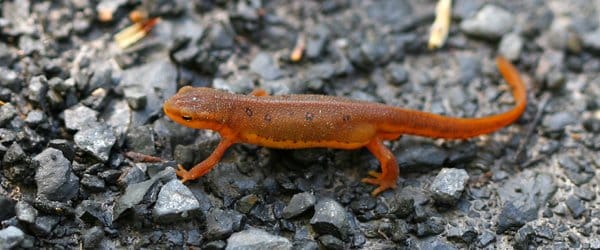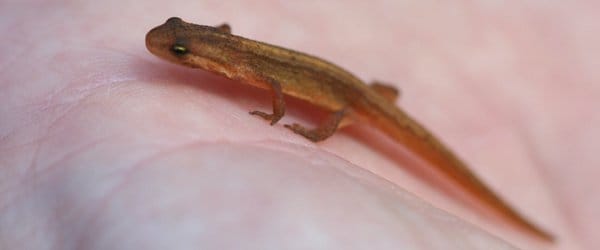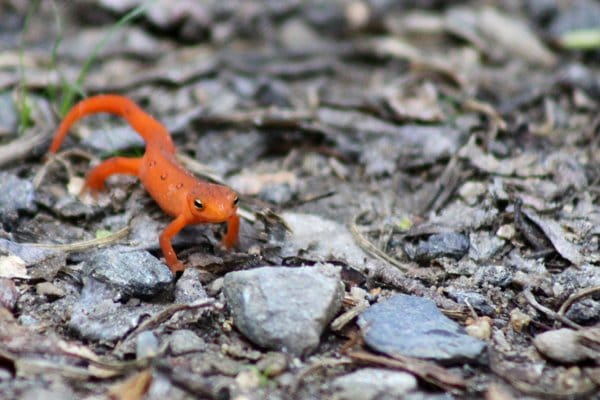Peasant: She turned me into a newt!
Sir Bedevere: A newt?
… … … …
Peasant: I got better.
The entire scene from which that bit of dialogue comes, in Monty Python and the Holy Grail, is one of my favorite scenes ever from a movie. The absurdity of mob rule is summed up well, I think, by the idea of a fully healthy human male saying out loud, as evidence of a woman being a witch, that “She turned me into a newt!” But what, exactly, is a newt?
Newts are salamanders, or, more precisely, newts are salamanders with three life phases – an aquatic larva phase, a land-living juvenile phase, and an adult phase that can be aquatic, or on land (though they return to water to breed). That is, all newts are salamanders but not all salamanders are newts. Newts can be found in Asia, Europe, and North America. The most familiar newt in eastern North America, where I live, is the Red Eft, which is the juvenile form of the Red-spotted Newt Notophthalmus viridescens, which is in the above image. The Smooth Newt Lissotriton vulgaris is the most common newt across most of Europe, and is also, as a matter of fact, called the Common Newt, and is most likely the type of newt that a witch would turn a peasant into in England. You can see what that one looks like in the image below.
Of course, there are many more kinds of newts (There are fourteen genera of newts!) but those two seem to be the two species that most people are likely to encounter or be turned into by witches. So, remember, don’t anger any witches and if you think someone is a witch just see if you can figure out if she weighs less than a duck.
Now get out there and find a newt! Who knows, it might be the victim of a vindictive witch!
…
















newts and salamanders were things I had only seen in biology text books before I came to Europe and they still fascinate the life out of me. they are like a lizard made of frog.
but you line of reasoning did make me wonder if newts could also be made of wood?
“Newts are aquatic salamanders with a land-living juvenile phase.”
I am a bit confused as that might only pertain to New World newts. European newts have an aquatic larva that transforms into a “real” newt which then lives on land except for a more or less short reproductive period in summer when they return to the water to lay eggs.
The Common Newt on your (or Hendrik’s? 🙂 ) hand is therefore a young “adult” newt that will turn into a fully-grown reproductive adult in the next one or two years and then return to the Kieshofer Moor’s pools to lay eggs and make more Common Newts. It is not a terrestrial juvenile phase.
@Dale Forbes: You had to go all the way to Europe just to see a salamander? Too bad! They were scurrying all around my grandparents’ eastern Florida town in the 80s.
@Corey: Thanks for making my day! Between the duck in the above reference, the dead parrot, and the infamous airspeed velocity of a swallow question, you could do a whole post just on Python references to birds. 🙂
@Jochen: Wow, I had assumed that they were all like the Red-spotted Newt. Thanks for the correction, which I have integrated into the post.
There’s a logic to the whole thing. 😉
God created natures laws which says people can’t regrow limbs but newts can.
Then He gave witches the power to turn people into newts.
So if you want to regrow a limb you first have to find a witch to turn you into a newt.
Then you’ll get better.
Makes perfect sense to me.